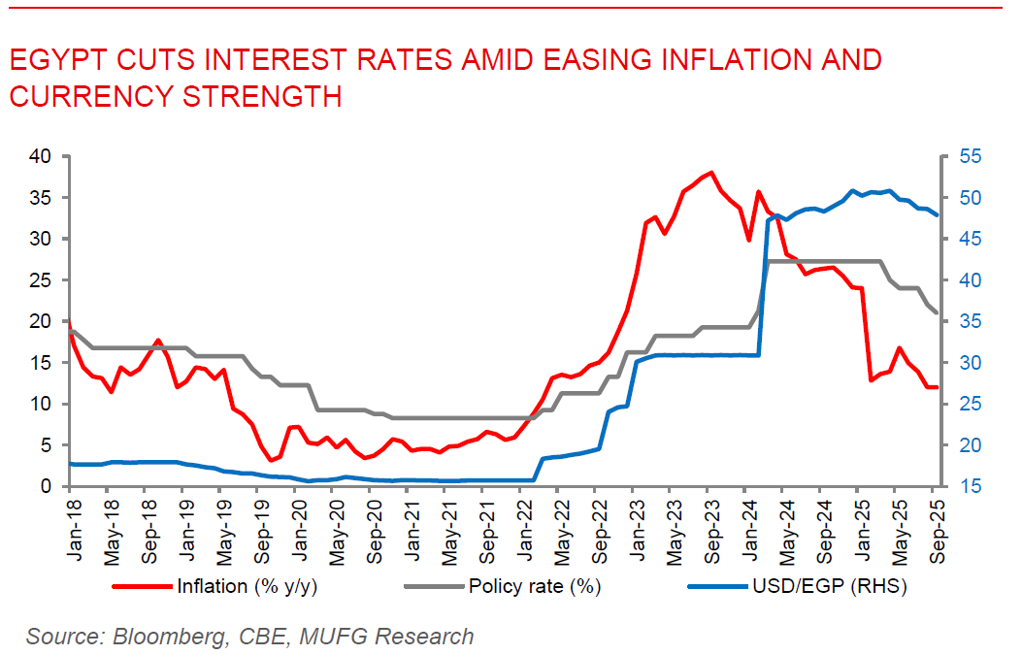To read the full report, please download the PDF above.
Middle East Daily
SOOJIN KIM
Research Analyst
DIFC Branch – Dubai
T: +44(4)387 5031
E: soojin.kim@ae.mufg.jp
MUFG Bank, Ltd. and MUFG Securities plc
A member of MUFG, a global financial group
Middle East Daily
COMMODITIES / ENERGY
OPEC+ supply fears push oil toward biggest weekly drop since June. Oil is heading for its steepest weekly drop since late June, pressured by expectations that OPEC+ will bring more idled supply back to the market, fuelling oversupply concerns. Brent hovered around USD64/b, down nearly 8% on the week, while WTI slipped below USD61/b. The alliance is set to meet virtually on Sunday to decide November output and may consider accelerating production hikes to regain market share. Early signs of excess supply are already visible in the Middle East, with the International Energy Agency forecasting a record glut next year, partly from revived OPEC+ output. In September, OPEC added 400,000b/d, fully reversing some of the cuts made in 2023, with Saudi Arabia lifting production in line with its quota, according to a Bloomberg survey. Looking ahead, market focus will be on OPEC+’s decision, the pace of returning barrels, and global demand resilience as surplus risks build.
Gold poised for seventh weekly gain amid US shutdown uncertainty. Gold hovered near USD3,860/oz, heading for its seventh straight weekly advance as the US government shutdown added uncertainty to the economic outlook and clouded the Fed’s rate cut path. Gold briefly hit a record earlier in the week before easing on profit-taking, though its sharp rally has left it technically overbought. With the shutdown delaying official jobs data, investors turned to private reports showing softer hiring and job cuts in September, while Fed officials acknowledged the data blackout complicates policy decisions. Markets still price in two more rate cuts this year, supporting gold, which has surged over 45% in 2025, on track for its biggest annual gain since 1979, underpinned by central-bank purchases and rising ETF inflows.
MIDDLE EAST - CREDIT TRADING
End of day comment – 02 October 2025. A real snoozer of a day in plain English. The market was firmer in the morning thanks to the tailwind macro markets provided. But away from some short covering and light inflows to begin the day, the market didn't see any follow through buying. In fact in the afternoon flows turned to net selling. Technicals are very strong, take again MUBAUH long end, where buyers seem to have given up on asking for offers since there is no offerside liquidity, marking 51s +0.5pt/-3bp. Then there is still the overhang of new issuance in the 5/10y bucket of IG names weighing on flows and spreads, ADGB for example got bid up in new 28s and bonds up to 35s in the morning just to fade and attracting more selling in the afternoon and bonds going out up to -0.125pt/2bp. The real market mover was MOROC today. The protests of the last days hadn't impacted the market so far. But with the first reported causalities the market had a second thought on the credit. Mainly long end traded but marking the curve anywhere from 0.25pt/0.75pt down and 7/8bp wider on average.
MIDDLE EAST - MACRO / MARKETS
Egypt cuts interest rates amid easing inflation and currency strength. The Central Bank of Egypt delivered is fourth interest rate cut of the year, lowering the overnight deposit rate by 100bps to 21% and the lending rate to 22%. The move reflects policymakers’ growing confidence in the country’s macroeconomic stabilisation, supported by easing inflationary pressures and a strong Egyptian pound following recent reforms. Inflation, which surged above 30% last year, has moderated in recent months, giving the CBE space to pivot toward growth-supportive measures. The rate cut also aligns with global monetary trends, as expectations of lower US interest rates have improved emerging market liquidity conditions. By easing borrowing costs, the central bank aims to stimulate private sector investment, ease financing pressures on businesses, and sustain Egypt’s economic recovery. The decision signals a careful balancing act between safeguarding price stability and bolstering domestic demand, as authorities pursue structural reforms and ambitious export targets to reinforce long-term resilience. Going forward, the pace of further cuts will likely hinge on the inflation trajectory, currency stability, and external financing conditions.
IMF praises UAE’s strong growth, diversification, and financing resilience. The IMF concluded its 2025 Article IV consultation with the UAE, highlighting the country’s robust economic performance and resilience amid global uncertainty. Real GDP is projected to grow 4.8% in 2025 and 5% in 2026, driven by non-oil sectors, alongside a rebound in hydrocarbon output. Inflation is expected to remain contained at around 2%, though rising housing costs pose affordability risks. The UAE’s fiscal policy remains prudent, supported by corporate tax implementation and strong sovereign buffers, while the financial sector is sound, with high capital and liquidity levels and growing private-sector credit. The Real estate remains buoyant but requires continued vigilance, and the UAE’s growing role as a hub for AI and virtual assets offers opportunities. Overall, the IMF commended the UAE’s diversification, fiscal discipline, and structural reforms as key to sustaining growth and resilience.

